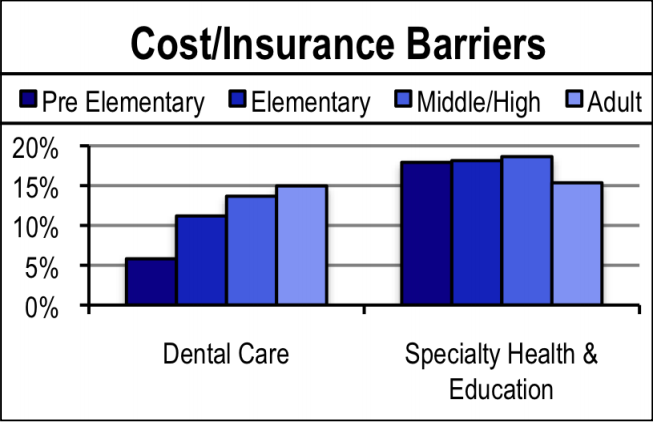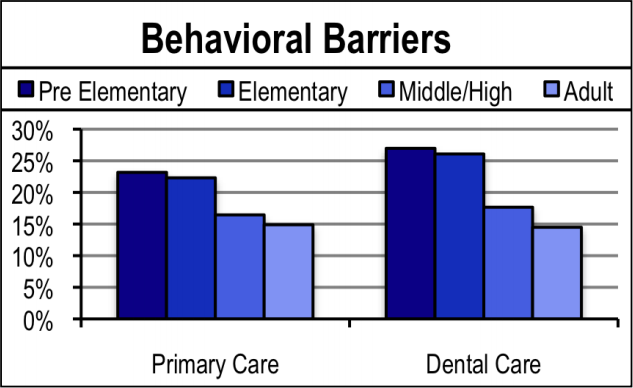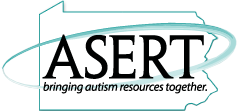
Report #3: Barriers and Limitations to Accessing Services
A Survey of Individuals and Families Living with Autism
About the Autism Needs Assessment
The Bureau of Autism Services, in its effort to improve care and quality of life for Pennsylvanians with autism and their families, conducted the PA Autism Needs Assessment. This effort has been a key task of the ASERT (Autism Services, Education, Resources and Training) Collaborative and has been led by University of Pennsylvania School of Medicine, Center for Mental Health Policy and Services Research and the Center for Autism Research at The Children’s Hospital of Philadelphia.
Autism Spectrum Disorders (ASD), referred to as autism throughout these reports, include Autistic Disorder, PDD-NOS, Asperger’s Disorder, Childhood Disintegrative Disorder and Rett’s Disorder. With more than 3,500 responses, the survey is the largest of its type to date in the nation. The findings from this needs assessment highlight challenges that Pennsylvanians with autism, of all ages, face everyday.
This report is the third in a series. The recommendations in this report address barriers and limitations to accessing services among Pennsylvanians living with autism.
Why Look at Barriers and Limitations to Accessing Services?
Individuals with autism and their families face multiple barriers to accessing services. Identifying and describing these barriers are critical steps in improving the systems that serve individuals with autism and their families. This report describes the barriers to accessing services for primary care, dental care, specialty health and education services, and family support services for individuals with autism and their families. See below for the list of the specific services included in each of these categories. Descriptions of these services can be found in the Service Needs Report #2 at www.paautism.org/asert. The needs assessment asked individuals with autism and their families about the following types of barriers: transportation, scheduling issues, behavioral issues, availability of service providers, and cost of care or issues with insurance coverage. This report concludes with specific recommendations to address barriers to accessing services for Pennsylvanians living with autism and their families across the lifespan
Barriers to Accessing Services
No Providers or Few Providers for Specific Services
- As individuals with autism age, they experience increasing difficulty in finding service providers.
- Almost half of caregivers of adults have difficulty accessing providers for specialty health and education services.
- Caregivers of, and individuals with autism in rural areas, more often report a lack of providers for specific services.
- Many providers of primary care and dental care often do not have the experience or expertise to serve individuals with autism, who may present behavioral challenges.
Barriers to Accessing Services

Cost/Insurance as a Barrier
- Almost 3 times as many caregivers of adults, as compared to caregivers of preschool age children, report cost or lack of insurance as a barrier to receiving dental services.
- Almost 1 in 5 caregivers report cost or lack of insurance as a barrier to receiving specialty health and education services.
- Individuals with autism frequently rely on Medicaid to pay for services. Not all providers accept Medicaid, however, limiting the availability of services.
Behavior Issues as a Barrier
- Caregivers of younger children with autism report behavior issues as the most common barrier to accessing primary and dental care services.
- This is especially true for dental care. For younger children, more than 1 in 4 caregivers report that a dental care provider will not care for their child due to behavior issues.
- Caregivers face difficulty finding providers who understand autism and have the training required to address the needs of an individual with autism, particularly adults with autism.
- Adults with autism face more difficulty when they age out of the pediatric care system, because adult providers often do not have the tools or training to provide services to individuals with autism.

Barriers to Accessing Services
Transportation as a Barrier
- Twice as many caregivers of adults with autism, as compared to caregivers of younger children, report transportation as a barrier to accessing services.
- Almost 1 in 4 caregivers of adults experience difficulty finding transportation to specialty health and education services.
- Adults who respond for themselves most often report that transportation is a barrier to accessing services.
- Even where it is available, public transportation may not be an option for individuals with autism and their families.

Recommendations
1. Increase the capacity of the Bureau of Autism Services adult programs to serve additional participants
The number of adult Pennsylvanians with autism is growing rapidly. Between 2010 and 2015, the number will increase by 265%, resulting in over 10,000 adults with autism.* There are currently insufficient resources to meet the needs of adults with autism (Report #2, Service Needs) and the extent of the problem will only multiply as more and more children transition to adulthood. Without additional capacity in the BAS programs, a crisis situation will develop. *See the PA Autism Census Report: www.paautism.org
2. Develop innovative models and solutions to address barriers and increase access to services.
Individuals with autism have complex needs that cannot be met by only one program or service delivery system. It is important to find new ways to connect people with autism to the services and supports that meet their diverse needs. Solutions need to be cost effective and make use of existing resources. As creative solutions are explored, there must also be a way to measure and evaluate their effectiveness. Both public and private sectors must be involved in finding ways to combine efforts to address the growing challenges.
3. Increase the number of service providers for individuals with autism and their families across Pennsylvania, particularly in rural areas.
A lack of local providers is the most frequently reported barrier to services across all age groups and all types of services. Developing incentives for providers to either practice in rural areas, or to use technology such as telemedicine, could increase access for individuals who otherwise would not receive care.
4. Increase the availability of transportation to care.
Caregivers of adults with autism reported difficulty accessing services due to a lack of transportation. Creating transportation options for individuals with autism and their families could help them get to the care they need. This may also require changes in billing options, so that providers can be compensated for transportation.
5. Increase awareness of insurance coverage for autism services.
Individuals with autism and their families struggle to pay for needed services. Many individuals with autism are Medicaid eligible, although not all are Medicaid enrolled. Educational campaigns are needed to make families aware of available resources such as Medicaid that can defray the costs of care. The recently-passed autism insurance mandate may increase coverage for autism services, but careful monitoring is needed to determine whether insurance companies are implementing the mandates as designed.
6. Train service providers to address behaviors that may accompany autism.
Caregivers of individuals with autism report that behavior issues can be a barrier to receiving care. Service providers, especially of general services like primary care and dentistry, require hands-on training and ongoing support to address these problems in their practice. An enhanced reimbursement rate for caring for children and adults with significant behavioral challenges could create incentives for primary care practitioners to provide care to this underserved population.
